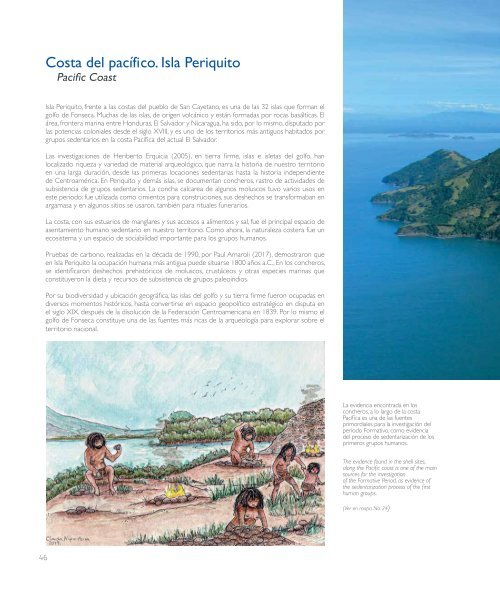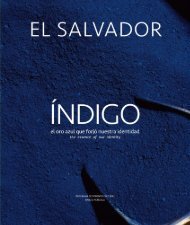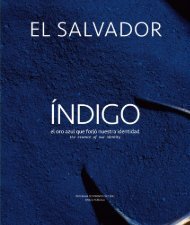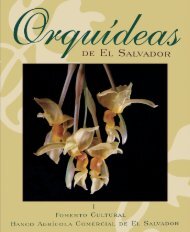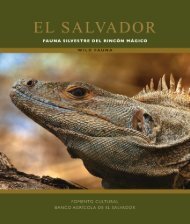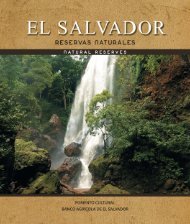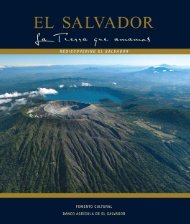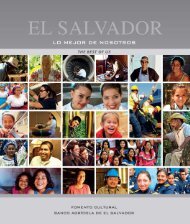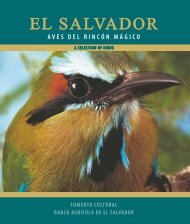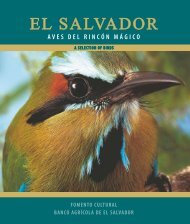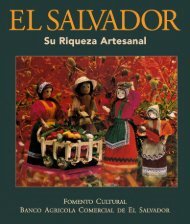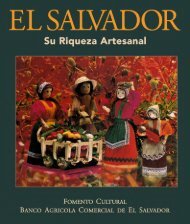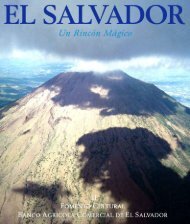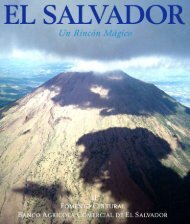La huella más profunda
Banco Agrícola se enorgullece al presentar un nuevo aporte a la cultura salvadoreña, al explorar los registros más antiguos de nuestra identidad: El Salvador. La huella más profunda, constituye un esfuerzo de divulgación de la información arqueológica prehispánica producida sobre nuestro país.
Banco Agrícola se enorgullece al presentar un nuevo aporte a la cultura salvadoreña, al explorar los registros más antiguos de nuestra identidad: El Salvador. La huella más profunda, constituye un esfuerzo de divulgación de la información arqueológica prehispánica producida sobre nuestro país.
You also want an ePaper? Increase the reach of your titles
YUMPU automatically turns print PDFs into web optimized ePapers that Google loves.
Costa del pacífico. Isla Periquito<br />
Pacific Coast<br />
Isla Periquito, frente a las costas del pueblo de San Cayetano, es una de las 32 islas que forman el<br />
golfo de Fonseca. Muchas de las islas, de origen volcánico y están formadas por rocas basálticas. El<br />
área, frontera marina entre Honduras, El Salvador y Nicaragua, ha sido, por lo mismo, disputado por<br />
las potencias coloniales desde el siglo XVIII, y es uno de los territorios <strong>más</strong> antiguos habitados por<br />
grupos sedentarios en la costa Pacífica del actual El Salvador.<br />
<strong>La</strong>s investigaciones de Heriberto Erquicia (2005), en tierra firme, islas e isletas del golfo, han<br />
localizado riqueza y variedad de material arqueológico, que narra la historia de nuestro territorio<br />
en una larga duración, desde las primeras locaciones sedentarias hasta la historia independiente<br />
de Centroamérica. En Periquito y de<strong>más</strong> islas, se documentan concheros, rastro de actividades de<br />
subsistencia de grupos sedentarios. <strong>La</strong> concha calcarea de algunos moluscos tuvo varios usos en<br />
este periodo: fue utilizada como cimientos para construciones, sus deshechos se transformaban en<br />
argamasa y en algunos sitios se usaron, también para rituales funerarios.<br />
<strong>La</strong> costa, con sus estuarios de manglares y sus accesos a alimentos y sal, fue el principal espacio de<br />
asentamiento humano sedentario en nuestro territorio. Como ahora, la naturaleza costera fue un<br />
ecosistema y un espacio de sociabilidad importante para los grupos humanos.<br />
Pruebas de carbono, realizadas en la década de 1990, por Paul Amaroli (2017), demostraron que<br />
en Isla Periquito la ocupación humana <strong>más</strong> antigua puede situarse 1800 años a.C., En los concheros,<br />
se identificaron deshechos prehistóricos de moluscos, crustáceos y otras especies marinas que<br />
constituyeron la dieta y recursos de subsistencia de grupos paleoindios.<br />
Por su biodiversidad y ubicación geográfica, las islas del golfo y su tierra firme fueron ocupadas en<br />
diversos momentos históricos, hasta convertirse en espacio geopolítico estratégico en disputa en<br />
el siglo XIX, después de la disolución de la Federación Centroamericana en 1839. Por lo mismo el<br />
golfo de Fonseca constituye una de las fuentes <strong>más</strong> ricas de la arqueología para explorar sobre el<br />
territorio nacional.<br />
Islas del Golfo de Fonseca.<br />
<strong>La</strong> evidencia encontrada en los<br />
concheros, a lo largo de la costa<br />
Pacífica es una de las fuentes<br />
primordiales para la investigación del<br />
periodo Formativo, como evidencia<br />
del proceso de sedentarización de los<br />
primeros grupos humanos.<br />
The evidence found in the shell sites,<br />
along the Pacific coast is one of the main<br />
sources for the investigation<br />
of the Formative Period, as evidence of<br />
the sedentarization process of the first<br />
human groups.<br />
(Ver en mapa No. 24)<br />
Periquito Island, located off the coast of San Cayetano, is one of the 32 islands of the Golfo de Fonseca. This islands are of volcanic origin and are formed<br />
by basaltic rocks. This area is the border between Honduras, El Salvador and Nicaragua, and has been, therefore, disputed by colonial powers since the<br />
eighteenth century, is one of the oldest territories inhabited by sedentary groups on the Pacific coast of present-day El Salvador.<br />
The investigations of Heriberto Erquicia (2005), on the mainland, and the gulf islands have found a variety of rich archaeological material, which tells the<br />
history of our territory for a long period of time, from the first sedentary locations to the independent history of Central America. In Periquito and other<br />
islands, shell sites are documented as an evidence of subsistence activities of sedentary groups. The shells had various uses in this period: they were used<br />
as foundations for constructions, their waste was transformed into mortar and in some places, they were used, also for funeral rituals.<br />
The coast, with its mangrove estuaries and access to salt and food, was the main space for sedentary human settlement in our territory. The coastal<br />
nature was an ecosystem and an important sociability space for human groups and until today it has remain.<br />
Carbon tests carried out in the 1990s by Paul Amaroli (2017) showed that the oldest human occupation in Periquito Island can be 1800<br />
years B.C. In the shell sites, prehistoric wastes of molluscs, crustaceans and other marine species that constituted the diet and subsistence<br />
resources of Paleoindian groups were founds.<br />
Due to its biodiversity and geographical location, the Gulf of Fonseca, its Islands and its mainland were occupied at various historical moments, until it<br />
became a strategic geopolitical space in dispute in the nineteenth century, after the dissolution of the Central American Federation in 1839. Therefore,<br />
the Gulf de Fonseca is one of the richest sources of archeology to explore on the national territory.<br />
46 47


